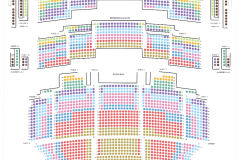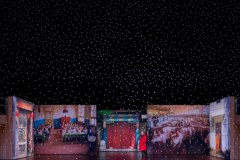Nixon in China
Mo | Tu | We | Th | Fr | Sa | Su |
Duration : 3h10 with 1 interval
Language : English
Surtitle : French / English
Opening:
First part 65 minutes
Intermission 30 minutes
Second part 95 minutes
End
In 1972, Richard Nixon visited Mao Zedong in China, marking the beginning of a rapprochement between the United States and China against the backdrop of the Cold War. Fifteen years later, American composer John Adams chose this episode as the subject of his first opera, a score marked by its rhythmic pulse, shimmering colours and intense lyricism.
The work entered the Paris Opera repertoire in 2023 in a production directed by Valentina Carrasco, who eschews realism in favour of the poetry of allegory and the magical, not without a touch of humour.
The common thread running through her dramaturgy is the metaphor of “ping‑pong diplomacy” – a reference to the first diplomatic overture through sport between China and the United States in 1971 – which combines with the metaphor of illusion to deliver spectacular images and a keen reflection on history and the vanity of power.
CHARACTERS
Richard Nixon: President of the United States
Mao Tse-tung: Chairman of the Chinese Communist Party
Pat Nixon: First Lady of the United States
Chiang Ch’ing: Mao’s wife
Henry Kissinger: US National Security Advisor
Chou En-lai: Chinese Prime Minister
Synopsis
First part
Act 1
Scene one – The airport outside Peking
It is a cold, clear, dry morning: Monday, February 21, 1972. Contingents of army, navy and air force circle the field and sing “The Three Main Rules of Discipline” and “The Eight Points of Attention.” Premier Chou En-lai, accompanied by a small group of officials, strolls onto the runway just as The Spirit of ‘76 taxis into view. President Nixon disembarks. They shakehands and the President sings of his excitement and his fears.
Scene two – Chairman Mao’s study
An hour later he is meeting with Chairman Mao. Mao’s conversational armory contains philosophical apothegms, unexpected political observations and gnomic jokes, and everything he sings is amplified by his secretaries and the Premier. It is not easy for a Westerner to hold his own in such a dialogue.
Scene three – The Great Hall of the People
After the audience with Mao, everyone at the first evening’s banquet is euphoric. The President and Mrs. Nixon manage to exchange a few words before Premier Chou rises to make the first of the evening’s toasts, a tribute to patriotic fraternity. The President replies, toasting the Chinese people and the hope of peace. The toasts continue, with less formality, as the night goes on.
Second part
Act 2
Scene one – Mrs. Nixon views China
Snow has fallen during the night. In the morning Mrs. Nixon is ushered onstage by her party of guides and journalists. She explains a little of what it feels like for a woman like her to be First Lady and accepts a glass elephant from the workers at the Peking Glass Factory. She visits the Evergreen People’s Commune and the Summer Palace, where she pauses in the Gate of Longevity and Goodwill to sing, “This is prophetic!” Then, on to the Ming Tombs before sunset.
Scene two – An evening at the Peking
Opera In the evening, the Nixons attend a performance of The Red Detachment of Women, a revolutionary ballet devised by Mao’s wife, Chiang Ch’ing. The ballet entwines ideological rectitude with Hollywood-style emotion. The Nixons respond to the latter; they are drawn to the downtrodden peasant girl – in fact, they are drawn into the action on the side of simple virtue. This was not precisely what Chiang Ch’ing had in mind. She sings “I am the wife of Mao Tse-tung,” ending with full choral backing.
Act 3
The last evening in Peking. The pomp and public displays of the presidential visit are over, and the main players all return to the solitude of their bedrooms. The talk turns to memories of the past. Mao and his wife dance, and the Nixons recall the early days of their marriage during the Second World War, when he was stationed as a naval commander in the Pacific. Chou En-lai concludes the opera with the questionof whether anything they did was good.
Program and cast
Opera in three acts (1987)
Creative team
John Adams: Music(1947)
Alice Goodman: Libretto
Kent Nagano: Conductor
Valentina Carrasco: Director
Carles Berga: Set design
Peter van Praet: Set and lighting design
Silvia Aymonino: Costume design
Mark Grey: Sound creation
Alessandro Di Stefano: Chorus master
Cast
Thomas Hampson: Richard Nixon
Renée Fleming: Pat Nixon
John Matthew Myers: Mao Zedong
Caroline Wettergreen: Chiang Ch’ing
Joshua Bloom: Henry Kissinger
Xiaomeng Zhang: Zhou Enlai
Aebh Kelly: Nancy Tang, first secretary to Mao
Ning Lang: Second secretary to Mao
Emanuela Pascu: Third secretary to Mao
The Paris Opera Orchestra and Chorus
Paris Opera Bastille
RM Europa Ticket GmbH is an officially accredited ticket reseller of/by Opera National de Paris.
Agency number: 4848428
Opéra Bastille
A great modern theatre
The Opéra Bastille is the work of the Canadian-Uruguayan architect Carlos Ott, who was chosen in November 1983 after an international competition that attracted entries from some 1,700 architects. The theatre was inaugurated on July 13th 1989.
Its architecture is marked by transparent façades and by the use of identical materials for both the interiors and the exteriors.
With its 2,700 acoustically consistent seats, its unique stage facilities, its integrated scenery, costume and accessory workshops, as well as its numerous work areas and rehearsal rooms, the Opera Bastille is a great modern theatre.
Stage facilities
Orchestra pit, mobile and adjustable, can be covered; at its largest it can house 130 musicians
Main stage, 45 m high, 30 m wide, 25 m deep, made up of 9 elevators allowing several levels to be created and supported by three main elevators, which bring scenery up from below stage
Clearing zones, 4 storage areas with the same dimensions as the stage
Backstage area, with its scenery turntable
Circulation area, scenery temporarily stored between the stage, workshops and rehearsal stage
Rehearsal stage, the Salle Gounod, with its orchestra pit and dimensions identical to those of the main stage
The building
Area at ground level: 22,000 m²
Floor area: 160,000 m²
Total height: 80 m (including 30 m below street level)
The auditoriums
The main auditorium
Area: 1,200 m², 5% of the total for the building
Dimensions: 20 m high, 32 m deep, 40 m wide
Number of seats: 2,703
Materials: blue granite from Lannelin in Brittany, pearwood from China, glass ceiling
The amphitheatre
Area: 700 m²
Depth : 21.4 m
Number of seats : 450
Materials: white breccia marble from Verona, staff ceiling
The Studio
Area: 280 m²
Depth: 19,5 m
Number of seats: 237
Materials: white breccia marble from Verona and pearwood

 EN
EN DE
DE IT
IT FR
FR ES
ES RU
RU JP
JP RO
RO
 Seating plan
Seating plan 


